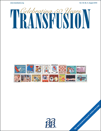Blood donors with hereditary hemochromatosis
Abstract
BACKGROUND: The distribution of C282Y and H63D variants of the HFE gene was determined in donors with evidence of phenotypical hemochromatosis. The ferritin level and the effect of a donation on iron status in the different HFE genotypes were studied.
STUDY DESIGN AND METHODS: Forty women and 107 men with hemochromatosis were compared to HFE wild-type donors. The influence of a blood donation was assessed by the change in ferritin between two consecutive donations.
RESULTS: In women and men, 85 and 59%, respectively, were C282Y homozygote. None of the women had H63D alleles. There was no significant difference in the donation history or the ferritin level between the HFE genotypes. Donation frequencies were, respectively, 3.3 and 3.7 per year for women and men. The ferritin level was significantly higher in women with hemochromatosis, while in men it was similar compared to the respective wild types. The negative influence of a donation on iron status was similar in hemochromatotic and wild-type women, while men with hemochromatosis were significantly less vulnerable to a blood donation than genetically wild-type men.
CONCLUSION: Subjects with hemochromatosis are valuable as blood donors independent of their HFE genotype. In general, the ferritin level tended to be higher in those with hemochromatosis than in wild types. The negative influence of a blood donation on iron status was less in male donors with hemochromatosis than in wild types.




